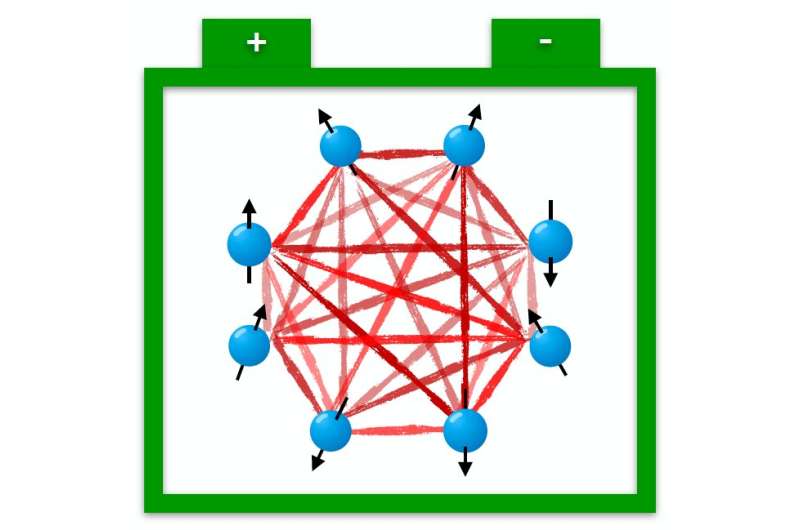A quantum battery constituted by a set of highly entangled spins in a fully connected and random network, named the SYK model. Credit: Rossini et al., PRL (2020). American Physical Society (APS).
The Sachdev-Ye-Kitaev (SYK) model, an exactly solvable model devised by Subir Sachdev and Jinwu Ye, has recently proved useful for understanding the characteristics of different types of matter. As it describes quantum matter without quasiparticles and is simultaneously a holographic version of a quantum black hole, it has so far been adopted by both condensed matter and high-energy physicists.
Researchers at University of Pisa and the Italian Institute of Technology (IIT) have recently used the SYK model to examine the charging protocols of quantum batteries. Their paper, published in Physical Review Letters, offers evidence of the potential of quantum mechanical resources for boosting the charging process of batteries.
"Previous theoretical studies laid down the idea that entanglement can be used to greatly speed up the charging process of a quantum battery," Davide Rossini and Gian Marcello Andolina, two of the researchers who carried out the study, told Phys.org, via email. "However, a concrete solid-state model displaying such fast charging was missing, until now."
Rossini, Andolina and their colleagues realized that the SYK model is a good candidate for examining the fast-charging process of quantum batteries, as it is known to generate highly entangled dynamics. The model's many-body, real-time dynamics are ultimately sufficiently complex for it to outperform standard analytic approaches.
"For our purposes, we found it convenient to employ a numerical treatment based on the exact-diagonalization of huge matrices," Rossini and Andolina explained. "We thus performed extensive numerical simulations, requiring up to 100 Gb of memory and around two weeks of computational time, on a high-performance computing cluster for scientific purposes."
The model used by the researchers is the first to clearly delineate a quantum advantage in the charging speed of quantum batteries. Although this model is particularly difficult to use in laboratory settings, the recent work by Rossini, Andolina and their colleagues was a first and important step toward collecting experimental proof of this quantum advantage.
"A battery is a rather complicated machine, which one would like to quickly charge, which should store energy for a long time and finally provide useful work," Rossini and Andolina said. "While we proved that quantum mechanical resources can boost the charging process, it is still unclear if they can be used to improve other tasks of such a hypothetical quantum battery, thus the investigation of quantum batteries is still at its infancy."
The recent study carried out by Rossini, Andolina and their colleagues offers strong numerical evidence hinting to the advantage of applying quantum mechanical forces in batteries, which is enabled by underlying highly entangled quantum dynamics. In the future, it could pave the way towards the development of more batteries that can be charged faster.
"An interesting possible addition to our work would be to apply the same concepts to thermal engines," Rossini said. "Since the 18th century, it [has been] known that the efficiency of a thermal engine cannot exceed a universal value known as the Carnot bound. Therefore, it is clear that quantum mechanical resources cannot be used to improve efficiency. However, no universal bound exists concerning the power, and we plan to study an SYK-based thermal engine to further investigate this issue."
More information: Quantum advantage in the charging process of Sachdev-Ye-Kitaev batteries. Physical Review Letters(2020). DOI: 10.1103/PhysRevLett.125.236402.
Journal information: Physical Review Letters
© 2021 Science X Network
























